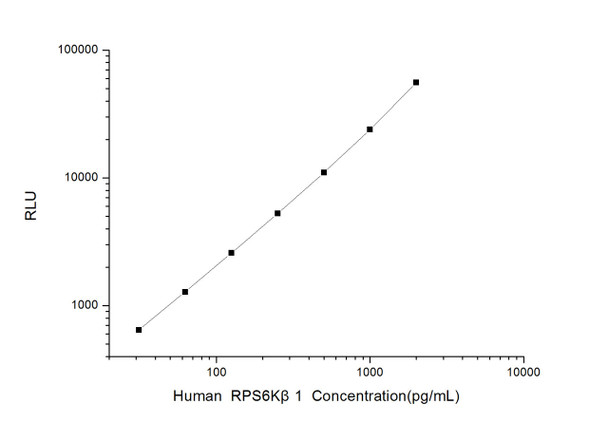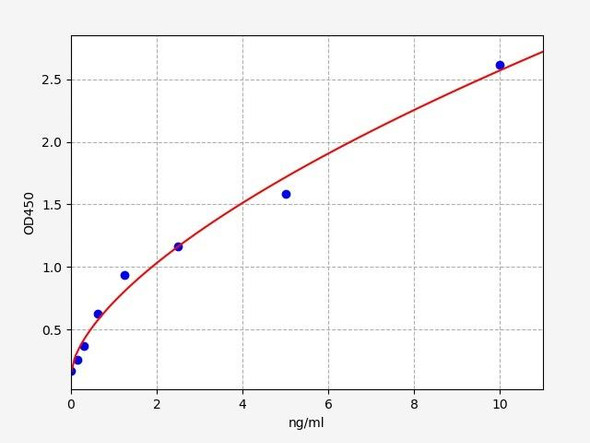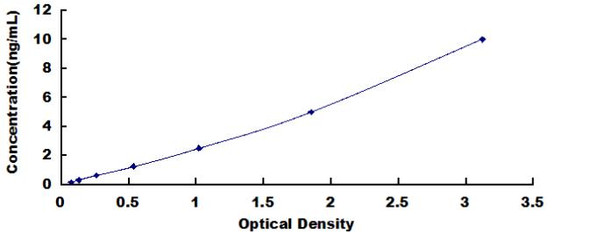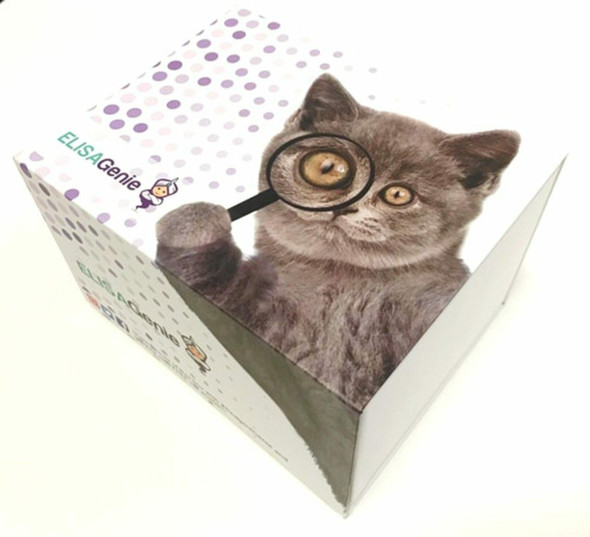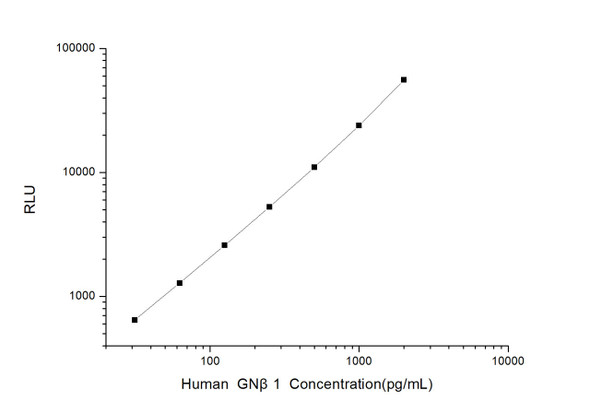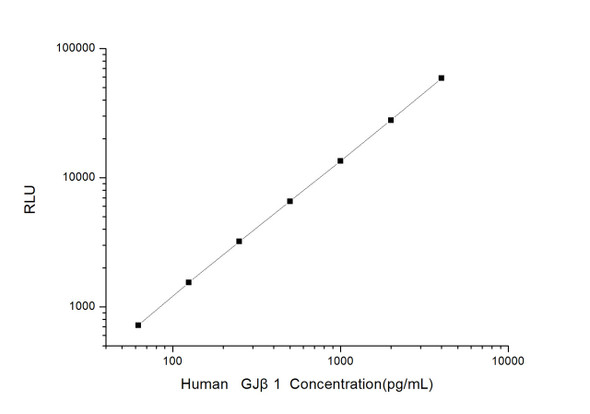Human Cell Death ELISA Kits
Human RPS6K beta1 (Ribosomal Protein S6 Kinase Beta 1) CLIA Kit (HUES00695)
- SKU:
- HUES00695
- Product Type:
- ELISA Kit
- ELISA Type:
- CLIA Kit
- Size:
- 96 Assays
- Sensitivity:
- 18.75pg/mL
- Range:
- 31.25-2000pg/mL
- ELISA Type:
- Sandwich
- Reactivity:
- Human
- Sample Type:
- Serum, plasma and other biological fluids
- Research Area:
- Cell Death
Description
| Assay type: | Sandwich |
| Format: | 96T |
| Assay time: | 4.5h |
| Reactivity: | Human |
| Detection method: | Chemiluminescence |
| Detection range: | 31.25-2000 pg/mL |
| Sensitivity: | 18.75 pg/mL |
| Sample volume: | 100µL |
| Sample type: | Serum, plasma and other biological fluids |
| Repeatability: | CV < 15% |
| Specificity: | This kit recognizes Human RPS6K beta1 in samples. No significant cross-reactivity or interference between Human RPS6K beta1 and analogues was observed. |
This kit uses Sandwich-CLIA as the method. The micro CLIA plate provided in this kit has been pre-coated with an antibody specific to Human RPS6K beta1. Standards or samples are added to the appropriate micro CLIA plate wells and combined with the specific antibody. Then a biotinylated detection antibody specific for Human RPS6K beta1 and Avidin-Horseradish Peroxidase (HRP) conjugate are added to each micro plate well successively and incubated. Free components are washed away. The substrate solution is added to each well. Only those wells that contain Human RPS6K beta1, biotinylated detection antibody and Avidin-HRP conjugate will appear fluorescence. The Relative light unit (RLU) value is measured spectrophotometrically by the Chemiluminescence immunoassay analyzer. The RLU value is positively associated with the concentration of Human RPS6K beta1. The concentration of Human RPS6K beta1 in the samples can be calculated by comparing the RLU of the samples to the standard curve.
| UniProt Protein Function: | p70S6K: an AGC kinase of the RSK family that is required for cell growth and G1 cell cycle progression. Is phosphorylated and activated by mTOR in mitogenic pathways downstream of phosphoinositide 3 kinase (PI3K). Phosphorylates the S6 protein of the 40S ribosomal subunit and is involved in translational control of 5' oligopyrimidine tract mRNAs. Activity is controlled by multiple phosphorylation events located within the catalytic, linker and pseudosubstrate domains. Mouse knockout shows symptoms of insulin resistance, and increased insulin senstivity, resulting in protection against diet-induced obesity. Protein expression and activation upregulated in colon adenocarcinoma cell lines. Increased expression in breast cancer correlated with poor survival. Selectively amplified and overexpressed within the 17q23 breast cancer amplicon. Two isoforms produced by alternative initiation have been reported. |
| UniProt Protein Details: | Protein type:EC 2. 7. 11. 1; Translation; Protein kinase, Ser/Thr (non-receptor); Protein kinase, AGC; Kinase, protein; AGC group; RSK family; p70 subfamily Chromosomal Location of Human Ortholog: 17q23. 1 |
| NCBI Summary: | This gene encodes a member of the ribosomal S6 kinase family of serine/threonine kinases. The encoded protein responds to mTOR (mammalian target of rapamycin) signaling to promote protein synthesis, cell growth, and cell proliferation. Activity of this gene has been associated with human cancer. Alternatively spliced transcript variants have been observed. The use of alternative translation start sites results in isoforms with longer or shorter N-termini which may differ in their subcellular localizations. There are two pseudogenes for this gene on chromosome 17. [provided by RefSeq, Jan 2013] |
| UniProt Code: | P23443 |
| NCBI GenInfo Identifier: | 54041234 |
| NCBI Gene ID: | 6198 |
| NCBI Accession: | P23443. 2 |
| UniProt Secondary Accession: | P23443,Q7Z721, B2R779, B4DLT4, B4DTG1, E7ESB8, F6UYM1 |
| UniProt Related Accession: | P23443 |
| Molecular Weight: | 525 |
| NCBI Full Name: | Ribosomal protein S6 kinase beta-1 |
| NCBI Synonym Full Names: | ribosomal protein S6 kinase, 70kDa, polypeptide 1 |
| NCBI Official Symbol: | RPS6KB1 |
| NCBI Official Synonym Symbols: | S6K; PS6K; S6K1; STK14A; p70-S6K; p70 S6KA; p70-alpha; S6K-beta-1; p70(S6K)-alpha |
| NCBI Protein Information: | ribosomal protein S6 kinase beta-1; p70 S6 kinase, alpha; ribosomal protein S6 kinase I; serine/threonine kinase 14 alpha; serine/threonine-protein kinase 14A |
| UniProt Protein Name: | Ribosomal protein S6 kinase beta-1 |
| UniProt Synonym Protein Names: | 70 kDa ribosomal protein S6 kinase 1; P70S6K1; p70-S6K 1; Ribosomal protein S6 kinase I; Serine/threonine-protein kinase 14A; p70 ribosomal S6 kinase alpha; p70 S6 kinase alpha; p70 S6K-alpha; p70 S6KA |
| Protein Family: | Ribosomal protein S6 kinase |
| UniProt Gene Name: | RPS6KB1 |
| UniProt Entry Name: | KS6B1_HUMAN |
As the RLU values of the standard curve may vary according to the conditions of the actual assay performance (e. g. operator, pipetting technique, washing technique or temperature effects), the operator should establish a standard curve for each test. Typical standard curve and data is provided below for reference only.
| Concentration (pg/mL) | RLU | Average | Corrected |
| 2000 | 55076 56366 | 55721 | 55693 |
| 1000 | 22226 25722 | 23974 | 23946 |
| 500 | 11587 10477 | 11032 | 11004 |
| 250 | 5030 5558 | 5294 | 5266 |
| 125 | 2609 2607 | 2608 | 2580 |
| 62.5 | 1328 1294 | 1311 | 1283 |
| 31.25 | 663 685 | 674 | 646 |
| 0 | 27 29 | 28 | -- |
Precision
Intra-assay Precision (Precision within an assay): 3 samples with low, mid range and high level Human RPS6K beta1 were tested 20 times on one plate, respectively.
Inter-assay Precision (Precision between assays): 3 samples with low, mid range and high level Human RPS6K beta1 were tested on 3 different plates, 20 replicates in each plate.
| Intra-assay Precision | Inter-assay Precision | |||||
| Sample | 1 | 2 | 3 | 1 | 2 | 3 |
| n | 20 | 20 | 20 | 20 | 20 | 20 |
| Mean (pg/mL) | 110.09 | 293.02 | 771.96 | 112.10 | 296.47 | 736.90 |
| Standard deviation | 13.97 | 25.84 | 57.82 | 12.29 | 27.42 | 68.16 |
| C V (%) | 12.69 | 8.82 | 7.49 | 10.96 | 9.25 | 9.25 |
Recovery
The recovery of Human RPS6K beta1 spiked at three different levels in samples throughout the range of the assay was evaluated in various matrices.
| Sample Type | Range (%) | Average Recovery (%) |
| Serum (n=5) | 90-102 | 96 |
| EDTA plasma (n=5) | 97-108 | 102 |
| Cell culture media (n=5) | 89-105 | 97 |
Linearity
Samples were spiked with high concentrations of Human RPS6K beta1 and diluted with Reference Standard & Sample Diluent to produce samples with values within the range of the assay.
| Serum (n=5) | EDTA plasma (n=5) | Cell culture media (n=5) | ||
| 1:2 | Range (%) | 95-110 | 84-98 | 84-96 |
| Average (%) | 102 | 91 | 90 | |
| 1:4 | Range (%) | 98-115 | 98-113 | 99-116 |
| Average (%) | 105 | 104 | 107 | |
| 1:8 | Range (%) | 98-111 | 93-107 | 93-110 |
| Average (%) | 105 | 99 | 100 | |
| 1:16 | Range (%) | 87-103 | 92-104 | 101-116 |
| Average (%) | 94 | 97 | 109 |
An unopened kit can be stored at 4°C for 1 month. If the kit is not used within 1 month, store the items separately according to the following conditions once the kit is received.
| Item | Specifications | Storage |
| Micro CLIA Plate(Dismountable) | 8 wells ×12 strips | -20°C, 6 months |
| Reference Standard | 2 vials | |
| Concentrated Biotinylated Detection Ab (100×) | 1 vial, 120 µL | |
| Concentrated HRP Conjugate (100×) | 1 vial, 120 µL | -20°C(shading light), 6 months |
| Reference Standard & Sample Diluent | 1 vial, 20 mL | 4°C, 6 months |
| Biotinylated Detection Ab Diluent | 1 vial, 14 mL | |
| HRP Conjugate Diluent | 1 vial, 14 mL | |
| Concentrated Wash Buffer (25×) | 1 vial, 30 mL | |
| Substrate Reagent A | 1 vial, 5 mL | 4°C (shading light) |
| Substrate Reagent B | 1 vial, 5 mL | 4°C (shading light) |
| Plate Sealer | 5 pieces | |
| Product Description | 1 copy | |
| Certificate of Analysis | 1 copy |
- Set standard, test sample and control (zero) wells on the pre-coated plate and record theirpositions. It is recommended to measure each standard and sample in duplicate. Note: addall solutions to the bottom of the plate wells while avoiding contact with the well walls. Ensuresolutions do not foam when adding to the wells.
- Aliquot 100µl of standard solutions into the standard wells.
- Add 100µl of Sample / Standard dilution buffer into the control (zero) well.
- Add 100µl of properly diluted sample (serum, plasma, tissue homogenates and otherbiological fluids. ) into test sample wells.
- Cover the plate with the sealer provided in the kit and incubate for 90 min at 37°C.
- Aspirate the liquid from each well, do not wash. Immediately add 100µL of BiotinylatedDetection Ab working solution to each well. Cover the plate with a plate seal and gently mix. Incubate for 1 hour at 37°C.
- Aspirate or decant the solution from the plate and add 350µL of wash buffer to each welland incubate for 1-2 minutes at room temperature. Aspirate the solution from each well andclap the plate on absorbent filter paper to dry. Repeat this process 3 times. Note: a microplatewasher can be used in this step and other wash steps.
- Add 100µL of HRP Conjugate working solution to each well. Cover with a plate seal andincubate for 30 min at 37°C.
- Aspirate or decant the solution from each well. Repeat the wash process for five times asconducted in step 7.
- Add 100µL of Substrate mixture solution to each well. Cover with a new plate seal andincubate for no more than 5 min at 37°C. Protect the plate from light.
- Determine the RLU value of each well immediately.

